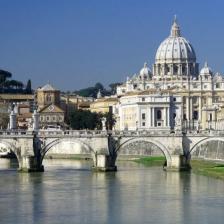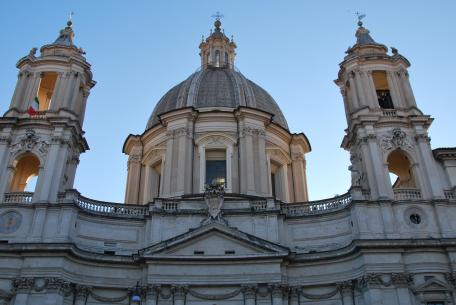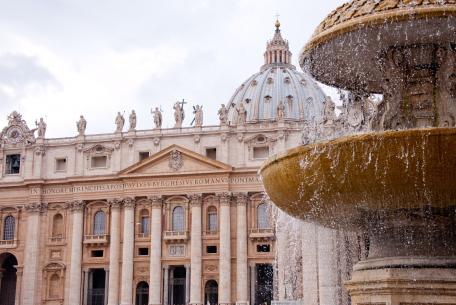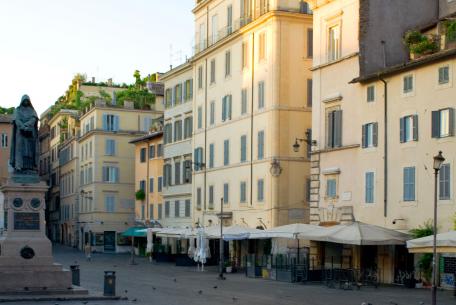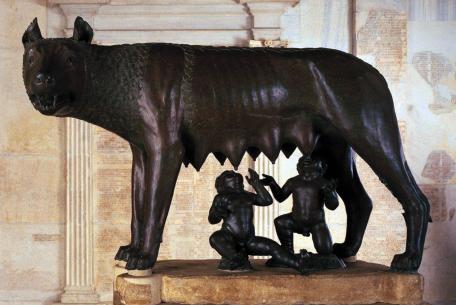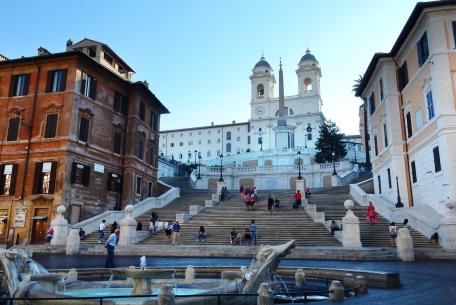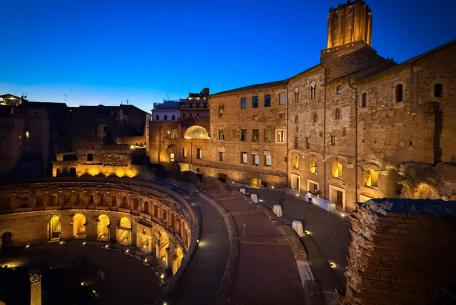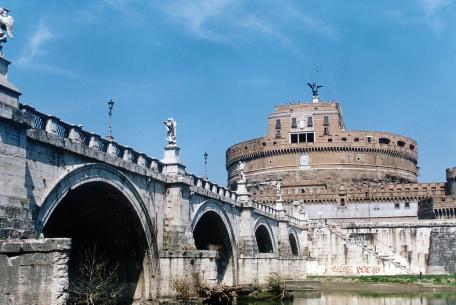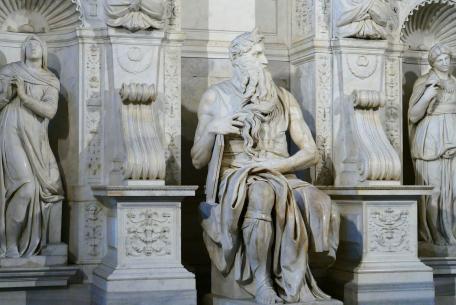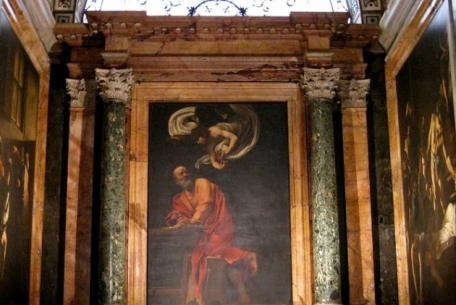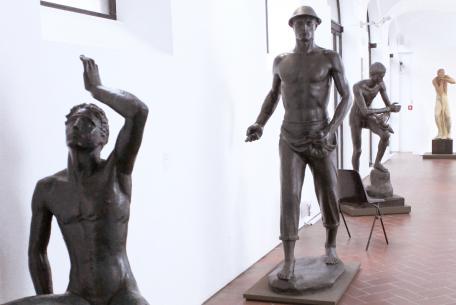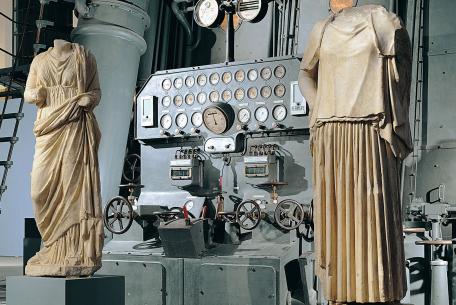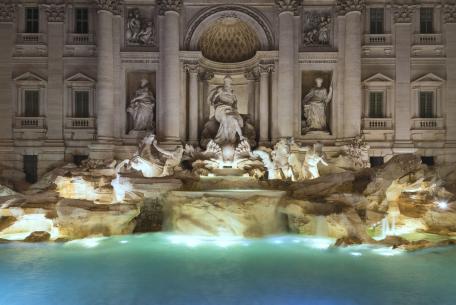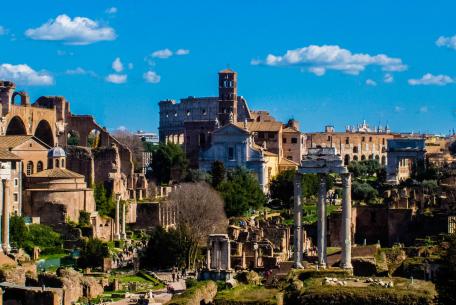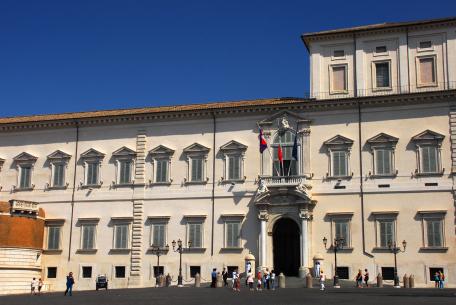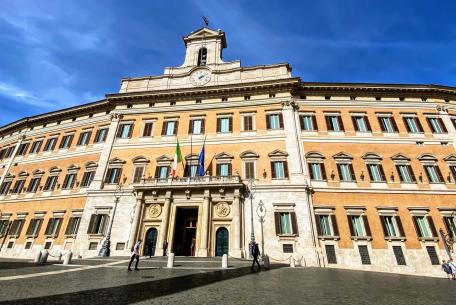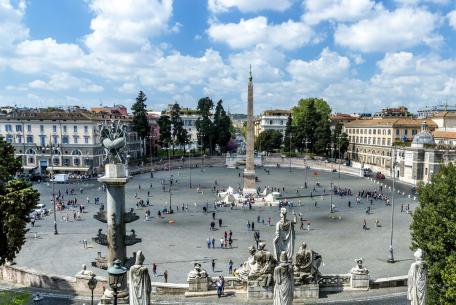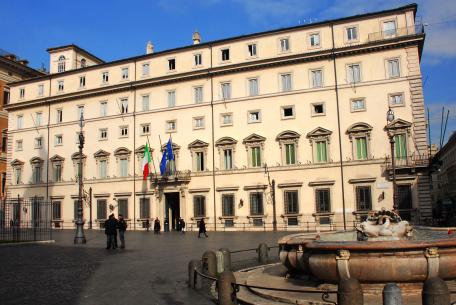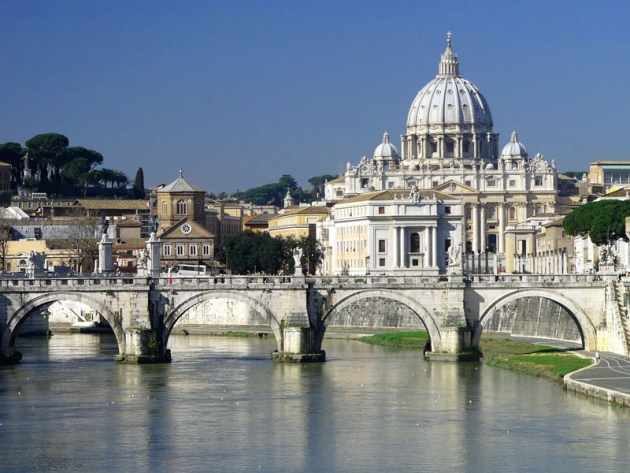
DAY 1
TO VISIT
Via dei Fori Imperiali
Foro Romano
Colosseo
Arco di Costantino
San Pietro in Vincoli
Rione Monti
Via dei Serpenti
Via Nazionale
Palazzo Esposizioni Roma
Galleria d’Arte Moderna
Trinità dei Monti
We recommend starting your tour from the via dei Fori Imperiali, a road that was built in 1932 to dissect the city’s main archaeological area: a genuine open-air museum. A short walk brings you to the Foro Romano which, having achieved monumental status mainly during the Republican age, was the heart of the city’s political and religious life. An archaeological wonder: from the Temple of Saturn to the Arch of Titus, from the Regia (an ancient area that functioned as a graveyard and holy place) to the Temple of Caesar, from the Arch of Septimius Severus to the Temple of Castor and Pollux. In the Palatine Hill (colle Palatino), to the right of the Arch of Titus, you can climb the oldest hill in the city. Tradition and various sources state that Rome was founded on the Palatine itself, where the so-called Roma Quadrata was built. Excavations in the Eighties brought to light traces of the first fortified city walls. From Augustus onwards, it was here that the Emperors would build their extravagant residences, on the ruins of what they thought was the hut of Romulus, founder of Rome. The great ruins of the palazzos of Augustus, Tiberius and Domitian still dominate the valley of the Circus Maximus; structures of up to 50 metres high that give an incredible view over the city.
The tour continues with a visit to the Colosseum (Colosseo). The Flavian Amphitheatre is the most imposing and best-known monument in Rome; it was opened in 80 A.D. by Emperor Titus who declared 100 days of festivities. A few figures to give you an idea: the height of the external wall is almost 50 metres; the major diameter of the ellipsis measures 188 metres while the minor is 156. The capacity of the Colosseum was never precisely established; it is generally thought to be approximately 73,000 spectators. The shows were public and free of charge; they were called munera (from the Latin munus meaning ‘gift’) or Ludi Gladiatori and consisted in duals to the death or hunting of ferocious animals. The games were beloved by the Roman people and gladiators often became the favourites of the audience, worshipped in the same way as modern sports stars. The gladiators - the name derives from gladium, the short sword used in the arena – were chosen among slaves, criminals and prisoners of war. If they managed to survive their duals, they might be released and earn large sums of money.
Next to the amphitheatre is the Arch of Constantine (Arco di Costantino), the largest and best-preserved of all the Roman arches. It was completed in 315 A.D. to celebrate the victory of Constantine, the first Christian Emperor, over Maxentius. The structure is mostly a combination of sculptures and architectural parts from different monuments. After visiting the Colosseum, continue along the via dei Fori Imperiali towards piazza Venezia. Halfway along on the right hand side is via Cavour, head down it for two reasons. The first is that after the first traffic lights, a staircase leads to the church of San Pietro in Vincoli where you can admire Michelangelo’s Moses. The second reason is that on the other side of the road to the staircase is the Rione Monti; smaller and less touristic than other areas, it combines modernity with the appeal of tradition. Despite its history – in ancient Roman times it was the Suburra area, reserved for the city plebs – it is now an enclave of young artists. Stroll through the cobbled seats to find many typical Italian trattorias, ethnic restaurants and wine bars in order to relax after this busy morning.
After lunch we recommend heading down the beautiful via dei Serpenti, so-called either because of a votive building showing the Madonna squashing snakes or because the palazzos in the neighbourhood was painted with the famous Laocoön Group covered in snakes, after the rediscovery of the statue on the Oppian Hill in 1506, near to Nero’s villa, the Domus Aurea.
This short walk will bring you to via Nazionale; where you can enjoy the window displays and perhaps make the odd purchase at the big fashion boutiques.
You will find Palazzo Esposizioni Roma along via Nazionale; designed by Pio Piacentini in neo-classical style, it was opened in 1883 to host the World Exposition of Fine Arts, the space is now used for important international exhibitions. We recommend heading to via Francesco Crispi from here (approx. 800 metres) where you can visit the Galleria d’Arte Moderna. It is a museum with a valuable patrimony for the history of collecting and art in Rome at the close of the nineteenth century and the early twentieth century. In addition to the symbolic Cardinal Decano by Scipione in 1930, visitors can admire pieces of Magical Realism, Second Futurism and a clear depiction of Italian sculpture from tradition to modernity: Giacomo Manzù, Carlo Carrà, Enrico Prampolini, Arturo Martini and Giorgio Morandi are some of the artists who documented Italian art in all its many aspects and its dialectic relationship with the European avant-garde.
If you finish your visit to the museum towards dusk, then you absolutely cannot miss a walk along Viale Trinità dei Monti, with its splendid views over the roofs and terraces of Rome, which are even more spectacular by Villa Medici, home to the French Academy.
DAY 2
TO VISIT
Piazza della Rotonda
Pantheon
San Luigi dei Francesi
Piazza Navona
Fontana dei Quattro Fiumi
Sant’Agnese in Agone
Museo di Roma di Palazzo Braschi
Piazza Campo de’ Fiori
The second day of your holiday begins at the piazza della Rotonda. Take some time to sit here and enjoy a one-of-a-kind view while sipping on a cappuccino. Raise your eyes and you will feel almost overwhelmed by the majesty of the Pantheon, one of the monuments that most exemplifies the cultural syncretism of our city: from a pagan temple, erected by Agrippa in 37 B.C. in honour of all the gods, it was transformed over the course of the seventh century A.D. into the Church of Santa Maria ad Martyres. The cylindrical building is covered by a hemispherical cupola made of cement paste which is still the largest in the world and is decorated internally with ceiling coffers in decreasing size (from low to high) which serve to lighten the structure. Thanks to the thickness of the walls, which decreases gradually going upwards, the self-supporting cupola is extraordinarily stable and is considered a real architectural masterpiece that would be hard to reproduce. A visit inside is truly emotional: the light filtered through the oculus, 9 m in diameter, which opens at the summit of the cupola, illuminating the enormous central hall where the kings of Italy are buried along with the most popular painter of the Renaissance, Raffaello Sanzio.
Head towards Via Giustiniani next, which will lead you to the church of San Luigi dei Francesi. Inside, do not miss the Contarelli Chapel (Cappella Contarelli) which is home to three splendid pieces by Caravaggio, dedicated to the life of Saint Matthew. They date back to 1599-1600. In the centre is The Inspiration of Saint Matthew while on either side are The Calling and The Martyrdom of Saint Matthew, two canvases that exemplify the new figurative language by Caravaggio: a current and realistic transposition of the holy story, where light is used as a protagonist in the scene.
Having exited from San Luigi dei Francesi, continue along via del Salvatore and cross corso del Rinascimento to reach Piazza Navona. This splendid oval-shaped space corresponds with the arena of the Stadium of Domitian below and is 240 metres long and 65 metres wide. The palaces surrounding it were built on the ruins of the terraces. The current Baroque style was thanks to Innocent X (1644-1655), Giovan Battista Pamphilj at the time, who wanted to celebrate the greatness of his family and also did so by building Palazzo Pamphilj. In the middle of the piazza is the spectacular Fountain of the Four Rivers (Fontana dei Quattro Fiumi) commissioned by the Pope to Gian Lorenzo Bernini. The piece represents the dominion of the church over the four known continents at the time, depicted as majestically carved rivers.
Opposite the fountain is the beautiful church of Sant’Agnese in Agone; its overall structure was designed by Francesco Borromini but between 1653 and 1657 he partially swapped the project with Girolamo Rinaldi. Among other modifications, he increased the distance between the two towers integrated into the façade and conceived of the concave façade to highlight the cupola. The piazza and surrounding streets are heaving with cafes, wine bars and restaurants with outdoor tables. We recommend picking one for a tasty lunch before continuing your tour.
Now this pleasant morning spent roaming piazzas and churches has come to an end, it is time to visit the Museo di Roma di Palazzo Braschi. This museum and its broad collection illustrate the main aspects of Rome’s social and artistic history from the late Middle Ages to the early twentieth century. Daily life, jobs, urban transformation: it is all documented in the works of Giovanni Paolo Pannini, Gaspar Van Wittel, Ippolito Caffi and Ettore Roesler Franz.
Once you have explored the museum, you are not far from Piazza Campo de’ Fiori: a piazza with a statue of Giordano Bruno in the centre and, all around, the city’s most colourful market. You can finally get down to some serious shopping: explore the roads that wind around the square for high-street fashion, tailor’s studios and vintage shops. When you’ve worn yourself out, enjoy a nice aperitif in one of the many bars overlooking the piazza.
DAY 3
TO VISIT
Basilica di San Pietro
Rione Borgo
Musei Vaticani
Stanze di Raffaello
Cappella Sistina
Castel Sant’Angelo
Ponte Sant’Angelo
Rione Trastevere
If this is your first time in Rome, you cannot miss the Vatican and surrounding neighbourhoods which together form the most representative image of papal Rome.
Dedicate your morning to visiting St. Peter’s Basilica (Basilica di San Pietro). As soon as you step inside the piazza – at the widest point it measures 340 x 240 metres – it will be immediately clear that you are in the emblematic location of Christianity. All around is a grandiose colonnade in travertine marble that, designed by Gian Lorenzo Bernini on commission by Pope Alexander VII (1655-1667), is composed of 284 columns and 88 pillars. The portico, formed of three consecutive arcades, opens level with via della Conciliazione to create a shape that Bernini himself suggested resembled the arm of the church welcoming its loyal worshippers. In the centre of the piazza is the Egyptian obelisk brought to Rome by Caligula (37-41 A.D.) which, like all the others located in front of the papal basilicas, is a symbol of the early power of the Papacy. The original St. Peter’s Basilica, a building of a similar size to the one today, was erected in around 320 A.D. by Constantine, the first Christian Emperor where tradition has it that the apostle Peter was buried. Over the centuries and under many different Popes, the greatest Renaissance artists all contributed to making it what it is today: Bramante, Raphael and Antonio da Sangallo. St. Peter’s Basilica is however considered to be Michelangelo’s masterpiece, because he conceived the majestic cupola and its surprising harmony and size. Its internal diameter reaches 43 metres and raises the height of the basilica, from the base to the top of the lantern, to over 130 metres. The interior of the church contains a wealth of mosaics and sculptures, the work of the most famous Italian masters, from Raphael to Canova. The central nave is dominated by the imposing Baroque baldachin in bronze and precious marble by Gian Lorenzo Bernini, who also created the magnificent pulpit above the central altar. The first chapel to the right as you come in is home to one of Michelangelo’s most famous and admired pieces of work, the Pietà. The master carved the group at the age of just over 20 years (between 1498 and 1499). His signature can be read on the fabric that wrapped around Mary, whose heavy-draped clothing is in contrast with Jesus’s smooth body.
Once you have visited the Basilica, why not relax with a traditional lunch in one of the many family-run trattorie along the nearby neighbourhood of Borgo, where you can enjoy some real Roman cuisine. Alternatively use the rest of the day to visit the Musei Vaticani or Castel Sant’Angelo.
If you choose to visit the Museums, you will have a chance to admire one of the most important art collections in the world. The first part of the Museums dates back to 1500, when Julius II (1503-1513) collected some masterpieces from classical sculpture in the Belvedere Courtyard, such as the Apollo Belvedere (copy of a bronze statue by Greek sculptor Leochares between 350 and 325 B.C.) or the Laocoön (copy of the Rodi original sculpted by Agesandor, Athenodorus and Polydorus). Over the course of the sixteenth century and the following centuries, the Vatican collection grew so extensively that from 1700 it was ordered into sections. Among the countless pieces conserved here, the frescoes in the so-called Raphael rooms (Stanze di Raffaello) and the Sistine Chapel (Cappella Sistina) deserve particular attention; they are extraordinary examples of the Italian Renaissance, the work of Raffaello Sanzio and Michelangelo Buonarroti.
If you decide to begin your afternoon tour at the Castel Sant’Angelo on the other hand, you will arrive by crossing Ponte Sant’Angelo, formerly Elio Bridge, which was built in 134 at the command of Emperor Hadrian to connect the left bank of the city – where the residential area was in ancient times – to his tomb, the so-called Hadrian’s Mole (Mole Adriana). Following the fall of the Roman Empire, the tomb was transformed into a fortress due to its proximity to the papal seat and its elevated position over the city. For centuries, Castel Sant’Angelo maintained its defensive role: a fortified passageway, known as the Passetto, leads from one of its bastions directly to the Vatican buildings. In case of a siege, the pope could quickly reach the castle stronghold which was considered impenetrable (and it was!). Fortress of the popes then, but also an excellent example of mannerist art: the entire apartment of Paul III (1534-1549), one of the greatest Renaissance pontiffs, is still home to frescoes and grotesque art by Perin del Vaga, Luzio Luzi and other students of the Raphael school. For many centuries it was also a dark prison. Anybody who opposed the papal power was locked in here. The Romans used to say that “whoever owned the Castle, owned Rome”.
A stroll along the banks of the Tiber leads to Trastevere where you can spend your evening. Restaurants open at all hours; bars and trendy clubs will lead you into the heart of a neighbourhood that expresses its true soul at night-time when it comes alive with street artists and musicians.
DAY 4
TO VISIT
Piazza del Popolo
Santa Maria del Popolo
Via del Corso
Via del Babuino
Via di Ripetta
Trinità dei Monti
Via dei Condotti
Via Frattina
Via Borgognona
Via delle Carrozze
Via Vittoria
Via della Vite
Piazza Colonna
Palazzo Chigi
Palazzo Montecitorio
Fontana di Trevi
Piazza del Quirinale
Scuderie del Quirinale
Today our walk begins from the Piazza del Popolo. Before beginning, breakfast in one of the famous cafes all around it is mandatory. Take a seat outside of course and, if you make some effort to eliminate the sound of passing vehicles, you’ll find yourself in nineteenth century Rome.
In the heart of the piazza, redesigned in neo-classical style by Giuseppe Valadier in 1823 is the obelisk – standing 24 metres tall – that Emperor Augustus brought from Egypt in 10 B.C. Alongside the Porta del Popolo is the church of Santa Maria del Popolo. Inside you cannot miss the Chigi Chapel (Cappella Chigi) designed by Raphael and the Cerasi Chapel (Cappella Cerasi), where visitors can admire two spectacular paintings by Caravaggio: The Conversion of Saint Paul and The Crucifixion of Saint Peter.
Fanning out from the Piazza del Popolo is the Trident. In the centre is via del Corso, to each side via del Babuino and via di Ripetta. Via del Babuino leads to piazza di Spagna and the stunning staircase of the Trinità dei Monti, at the feet of which, built between 1723 and 1726 to designs by architect Francesco De Sanctis, lies the Fountain of Barcaccia, carved in the late 1720s by Pietro Bernini and his much more famous son Gian Lorenzo Bernini.
Finish off the morning with a wander around the so-called shopping streets. Via dei Condotti is the street for Italian Haute Couture, while in past centuries it was the meeting point for foreign artists living in Rome, who used to meet at the suggestive Caffè Greco: Goethe, Byron and Wagner were all clients of this café which opened in 1760. We recommend a coffee break to breathe in the history! But do not neglect to visit via Frattina, via Borgognona, via delle Carrozze, via Vittoria and via della Vite: streets rich in history and at the same time symbolic of glamour and elegance. The rows of shops draw the eye with catch window displays and the biggest fashion brands also have a spot here, where the elegant dresses so often admired on the covers of magazines blend in with the almost austere architecture of the buildings. If you are a fan of exclusive elegance, you can not only make a few purchases here but even find the very best customised tailor services.
Continue walking along Via del Corso, a straight line where horse races used to take place during the Carnival; shopping is more accessible here where middle-range shops have their showrooms but are still attentive to new trends alongside the most famous sports brands.
It’s time for lunch! Why not take a break around Piazza Colonna, where you will find many pubs and restaurants that may well be inspired by roman tradition but have mixed it with influences from Slow Food or vegetarian and vegan cuisine. The only downside is that these are not the cheapest places to eat! Cross Piazza Colonna to see two palazzos that make the news on a regular basis: Palazzo Chigi, home to the Presidency of the Council of Ministers and, a little further ahead, Palazzo Montecitorio, home to the Chamber of Deputies.
We will now continue along Via del Corso, making a slight detour to the left to get to one of the city’s most iconic sports. Immortalised by Federico Fellini in La Dolce Vita, the Trevi Fountain (Fontana di Trevi) is the biggest and most famous Roman fountain. Built between 1732 and 1762 to plans by Nicola Salvi, the exuberant setting was inspired by the theme of the Ocean kingdom. The statues and elevations rise from the travertine marble reef which in turn descends into the large basin, opposite which a curved terrace with seats forms the cavea to this complex scene. The streets around the fountain heave with small craft and souvenir shops, you are spoiled for choice!
While we’re on the subject of there being too much choice, it is said that even a lifetime does not suffice to really know Rome. So it is natural that any tour will be the result of a selection. Not everything can be included. But do not despair! Given this, we thought it appropriate to conclude our tour with another emblematic location. It is just a few hundred metres from the Trevi Fountain, but unfortunately for you, it’s an uphill walk! Via della Dataria comes out in piazza del Quirinale, home to the palazzo of the same name which has been the official residence of the President of the Republic since 1947 and prior to that had been the Savoia mansion since 1870, following the annex of Rome to the Kingdom of Italy. Originally, however, the Palazzo del Quirinale, built in the 1670s and expanded over the following century by great Baroque masters (such as Domenico Fontana, Carlo Maderno and Gian Lorenzo Bernini to name just a few), was destined to be a summer residence for the Pope. Visit www.palazzo.quirinale.it to book a visit but be aware that the reservation must be made five days in advance.
If you still have the energy and there’s an exhibition that appeals to you, we recommend a visit to the nearby Scuderie del Quirinale. Built over a decade (1722-1732), as service buildings to the larger palazzo, the Scuderie were transformed in 1999 after a campaign for restoration and renovation into exclusive gallery spaces. Please note that the Scuderie are open until 10.30pm on Fridays and Saturdays.
After a tasty aperitif in the pleasant café (on the mezzanine floor), spend an alternative evening here! Once you have explored the exhibition, do not miss the magnificent view over the city from the glass window designed by Gae Aulenti as part of the work in the late twentieth century.
DAY 5
TO VISIT
Basilica di San Paolo fuori le mura
Centrale Montemartini
Il palazzo dipinto da Blu
Piramide Cestia
Colosseo
Vittoriano
Musei Capitolini
Piazza del Campidoglio
Mercati di Traiano - Museo dei Fori Imperiali
If you are coming from Fiumicino Airport or Civitavecchia Port, or if you simply wish to see something a bit different, we recommend this tour that shows just how many different faces our city has. Given that it is harder to access this part on foot, we will also provide some information on how to get around. If coming from Fiumicino or Civitavecchia, it is best to take a regional train (line FL1 from the Airport, FL5 from the Port) and get off at Ostiense station. From here, take the metro (Line B towards Laurentina) until the stop Basilica San Paolo. In just a few minutes you will be in front of the Basilica of St. Paul outside the Walls (Basilica di San Paolo fuori le mura), one of the most important sites in Christian Rome. Unfortunately, the fire of 15 July 1823 caused the collapse of a large part of the ancient structure. What we see today is the result of reconstruction between 1825 and 1854, which recreated the original structure fairly faithfully. It was a typical paleochristian basilica with three naves separated by rounded arches. Fortunately, the presbytery survived the flames as did some extraordinary medieval items such as the ciborium by Arnolfo di Cambio (1285) and the Easter candelabra by Vassalletto. Nor did the cloisters, which date back to the early thirteenth century, undergo severe damage and are a typical example of so-called cosmatesque Roman art.
After visiting St. Paul’s outside the Walls, head towards the Centrale Montemartini. Take the metro towards Rebibbia/Conca d’Oro until the stop Garbatella, then follow directions for the Centrale. This gallery has been located within the former Giovanni Montemartini thermoelectrical power station since 1997, when an exhibition entitled ‘Le macchine e gli dei’ was organised because several sculptures were temporarily moved due to renovation of parts of the Musei Capitolini. These masterpieces of ancient sculpture (including the Musa Pensosa and Togato Barberini) and precious mosaics from the early fourth century were exhibited alongside old machines in a suggestive play of contrasts. The exhibition was made permanent in 2005.
If these initial two stops have taken up most of your morning, head over to Via del Porto Fluviale (a stone’s throw from the Centrale Montemartini), where you will be spoilt for choice for lunch: from Slow Food or ethnic restaurants to trendy wine bars. But before that, don’t forget to admire the palazzo painted by Blu (via del Porto fluviale corner via delle Conce), internationally renowned Italian street artist. The former barracks of the Air force was occupied in 2003 and is now dominated by 27 enormous faces. The windows have become the eyes of these characters, which are inspired by the world of comics and graphics, both in terms of the bright colours and the drawing style.
Your afternoon might begin with a nice walk to the Pyramid of Cestius (Piramide Cestia), which rises almost up to 37 m on the western side of piazzale Ostiense. It is the burial tomb of Gaius Cestius Epulone, an important figure in pre-Augustan Rome. It was built in 330 days (in concrete, bricks and Carrara marble) by the heirs of the deceased who would otherwise not have been eligible for their large inheritance, as we are told by the inscription on the western side of the monument. Inside is a small burial room with a barrel vaulted ceiling and original frescoes in the Pompeii style. The volume of the funeral cell is just over 1% of the entire pyramid which is much slenderer than the Egyptian pyramids. When Egypt became a Roman province in 30 B.C., its artistic culture thoroughly penetrated Rome, just as the Greek culture had when it definitively became part of the Roman Empire in 27 B.C.
From here, take the metro from the stop Pyramid (line B, direction Rebibbia/Conca d’Oro) and get off at the Colosseum. Since you have already seen Rome’s most famous monument, at least from the outside (see Day 1 of this tour for further information), keep walking along via dei Fori Imperiali which will bring you to Piazza Venezia, dominated by the marble Altar of the Fatherland (Altare della Patria). This monument dedicated to fallen soldiers was built between 1885 and 1905 and was designed by architect Giuseppe Sacconi.
Now you have two options for the end to your busy day in Rome.
The first is to visit the Capitoline Museums (Musei Capitolini). To the right of the Altar of the Fatherland, climb up to piazza del Campidoglio, which was designed by Michelangelo for a commission by Paul III in the mid-sixteenth century. In the centre of the piazza is the copy of a bronze statue of Marcus Aurelius. The original was recently restored and is exhibited inside the museums in a new space named Esedra, a prestigious architectural project for the museum complex which is formed by two historic buildings: Palazzo Nuovo and Palazzo dei Conservatori, symbols of the city’s civic power since the Middle Ages. Inside the Palazzo dei Conservatori you will find the Conservator’s apartment which is home to ancient sculptures and mannerist frescoes. Do not miss the Pinacoteca on the second floor with work by Caravaggio, Carracci and Domenichino among others.
The second option is to visit the Museum of Imperial Fora and Trajan's Markets (Mercati di Traiano - Museo dei Fori Imperiali). This also offers an excellent view over the Forums since the access is to the north. Multimedia technology reconstructs the structure and function of the various buildings in the Forum, which were erected to match topographically with the Roman Forum from the royal-republican age and to fulfil its religious, political and administrative function.
 Condividi
Condividi












































